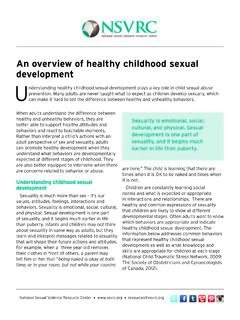Transcription of How the Portrayal of Black Women has shifted from Slavery ...
1 Running head: Shift in Portrayal of Black Women in America 1 How the Portrayal of Black Women has shifted from Slavery times to Blaxploitation films in American Society Tiffany S. Francois High Point University Shift in Portrayal of Black Women in America 2 Abstract Women have long been negatively stereotyped in American society, usually portrayed as submissive and passive while at the same time seen as disobedient and pushy.
2 These contradictory representations are doubly imposed on Black Women . The knowledge that we have about Black Women during Slavery shows two main descriptions: a sexual object for the master s pleasure or a mammy figure that devotes all her time to her master s family instead of her own. Unwanted sexual harassment caused Black Women to take on the de-sexualized role of the mammy to try and get away from the horrible sexual acts committed against them. During the Blaxploitation film craze of the 1970 s Women seemed to gain more control over their sexuality, lives and destinies, at least in the movies. The strong Black woman representation was prominent throughout Blaxploitation films and featured heroines taking control over their lives, as well as the things and people that mattered to them. This article seeks to examine the parallels and distinctions of representations of Women during the Slavery era with that of Blaxploitation films, while exploring how this the Portrayal affects the shifting values, identities and ideologies of Black Women .
3 Keywords: Slavery , Blaixploitation films, Women stereotypes, Black Women stereotypes, Women in media Shift in Portrayal of Black Women in America 3 How the Portrayal of Black Women has shifted from Slavery times to Blaxploitation films in American Society Black Americans have endured numerous hardships since their involuntary migration and subsequent enslavement from Africa to America. Many scholars would say that the physical captivity of Slavery has been transformed into a more mental captivity, in the way that mainstream American culture has systematically fostered racism and discrimination. The despicable imprisonment of African slaves in every way, especially physically and mentally, still affects Black American values, identities and ideologies to this day.
4 These hardships and issues were and still are compounded within the lives of Black Women . The representation of Black Women throughout history has affected the way Black people, as well as American society, values, identifies and idealizes Black Women in general. There have clearly been changes in these ideologies over time and they seem to become present after any type of representation in the media of Black Women . This paper seeks to examine the parallels and distinctions of representations of Women during the Slavery era with that of Blaxploitation films, while exploring how this the Portrayal affects the shifting values, identities and ideologies of Black Women . Slavery Era There are not many slave narratives about Women , but of the few, a deep comprehension and recognition of the emotional anguish and suffering is brought to light through their stories. A great example of this is the narrative by Harriet Jacobs, Incidents in the Life of a Slave Girl, in which she critiques racism, the institution of Slavery and even patriarchy.
5 Jacobs descriptively characterizes how it feels to be a slave girl Shift in Portrayal of Black Women in America 4 transforming into a Women rather than just the physical blunt imagery, usually characterized male slave narratives. Harriet tells her story through the alias, Linda, who is the main character and protagonist. Linda begins talking about her father dying and her life with her grandmother, who she was very close to. She explains that her father taught her and her brothers free will and to feel like they were human beings, although it was very dangerous for a slave. The more a slave possessed the notion of their own free will, the more likely they were to be disobedient, run away and be of no use to their owner.
6 Slaves were supposed to think that they were less than human so that the masters not only had physical control over them but psychological control as well. This sense of all- consuming control was even more prominent for slave Women due to the extra control slave owners had over their sexuality and paternity of children. Jacobs exemplifies this when she describes Linda being sexually harassed day in and day out by her master. He would write her sexually explicit notes about what he wanted to do with her, accost her and make her feel very uncomfortable being around him. She says My master met me at every turn, reminding me that I belonged to him, and swearing by heaven and earth that he would compel me to submit to him (Jacobs, ) which clearly embodies that sense of control mentioned previously. Linda s experience of sexual harassment by her Master and the jealousy of his wife is similar to experiences of many other female slaves, she listens to violent outbreaks of jealous passion, and cannot help understanding what is the cause (Jacobs, ).
7 The sense of free will instilled in Linda at a young age shined through her actions despite the harassment and abuse from both of her masters. She refused to become totally Shift in Portrayal of Black Women in America 5 victimized by her master and chose when and with whom she would have sex with. Although this person was not someone that she loved, she was in control of her own sexuality and body to a certain extent. This was very unusual for a girl during this era, much less a Black slave girl, and it really speaks about her determination to change her fate as a slave girl. The incidents in the life of Harriet Jacobs are extremely telling of what Black Women were supposed to be like and her fight to define her own sexuality instead of letting her master or anyone else, for that matter, define it for her.
8 In Jacob s narrative she describes two opposing representations of Women during Slavery times and both are awful: one is a walking breeding ground and exotic sexual figures for their masters and the other is the insignificant Mammy figure who had no control over their families. Both were objectified by their masters and hated furiously by the masters wives. The Black girl was pitied as she was approaching puberty because of the inevitable harassment, degradation and force placed upon her sexually, especially if she happened to be beautiful. Masters had sex with their female slaves, impregnated them and then adhered to the wife s wish to separate her children by selling them to another plantation. This cycle happened continuously and frequently during Slavery and as a result in many cases forced slave Women to create a sense of non-sexuality. Slave girls and Women willfully made themselves the least appealing, unattractive and undesirable to avoid the heartache of rape, children by their own master and then never seeing those children again.
9 Now of course this tactic may have only worked maybe half of the time, if that, but it does explain the birth of the stereotypical Mammy figure. Shift in Portrayal of Black Women in America 6 Mammies are characterized as a loyal domestic servant to White [that] loves, takes care of, and provides for her white family over her own (Woodard & Mastin, 2005, ). Black Women may have over compensated in their devotion and sexually neutrality for fear of the previously stated repercussions, therefore creating the breeding ground for this stereotype to be born. However, the longevity of this depiction of Black Women can be explained by the restriction of Black Women to domestic service (Woodard & Mastin, 2005).
10 Long after Slavery was abolished, Black Women were still negatively portrayed as mammies throughout the media. In the era of radio and even television there were many shows in which Black characters were not only stereotypical, but also portrayed as submissive, incompetent, sneaky and shrewish (Isaksen, 2012, ). In Isaksen s (2012) article on racial formation theory acted out through radio, she talks about a radio show featuring Aunt Jemima who was played by a succession of three white Women who entertained listeners with breakfast recipes, minstrel songs, and housekeeping hints ( ). This perfect stereotypical mammy influenced those listeners to actually believe that this was how Black Women really were. These portrayals created a shift in the values, identities and ideologies that Black Women had for themselves. Black Women became selfless and thought of their own families before themselves, which is ironic, because in order to do this, they had to take on these characteristics for the White family that owned them in Slavery times or the White family they worked for during post- Slavery times.










